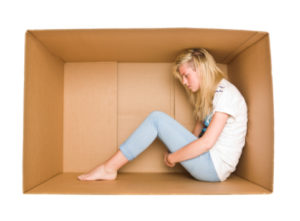Three Ways to Make Bad Feelings Less Sticky
Every client I have worked with shares their despair that their bad feelings won’t go away, and that nothing they do makes it better. Getting distracted for a while by being busy; sleeping; vegetating in front of a screen or immersing yourself in a job doesn’t take away, lessen or alleviate the bad feelings – they persist and make you feel bad about having bad feelings. Bad feelings make you beat yourself up for being negative, adding to the already large stack of bad feelings you have loaded in your hard drive.
Bad feelings – expressions of how bad feelings invade your body and mind
“I was so happy that everyone in my family was getting along and enjoying dinner, but suddenly I felt like an outsider. What if my mom was just pretending to like my wife?” mistrust about the intentions of loved ones.
“I was fine all morning until I checked Facebook and saw a post by my ex-partner smiling at another woman – my heart raced and my head thumped. I was like jelly – I had to keep scrolling and scrolling and checking even though I felt nauseous – did he care for me at all? Is he really over me?” Feeling invisible, irrelevant and rejected.
“I wanted to go out for a hike and take my kids with me. My wife accused me of abandoning her and being a bad example to the children. I felt so bad, so shamed, so untrusted, so unworthy that I couldn’t speak to her for days. I felt like a shitty person and it was sickening.” Diminished, demeaned, belittled, emasculated, misrepresented, attacked, made into a bad guy.”
Bad feelings that stick around are grounded in insecure attachments and brain responses
The quotes above are all versions of cries of pain that are universal in relationships when attachments are insecure. The American Orthopsychiatric Association, 2013, reports that people with insecure attachments experience greater emotional dysregulation, and reduced ability to regulate the negative emotions that result in anxiety and depression.
The greatest difference between those who had a secure attachment style compared to those who had an insecure attachment style was that the former were much better at regulating their emotions stabilizing their nervous systems. In addition those with insecure attachments were ‘nonaccepting’ of their negative emotions, and engaged in more impulsive behavior to escape the intolerable feelings. So we can see that if you don’t accept negative emotions then you won’t attempt to develop strategies to help with the dysregulation – you’ll just have a knee jerk reaction which is unlikely to be successful – ending up in the same cycle over and over again.
What makes these bad feelings so bad over and over again?
Intense bad feelings of dysregulation are intolerable so it’s natural that you are going to want to escape – whether it’s through alcohol, opiates, other mind-altering substances, stuffing food, exercising till you drop, playing video games, or gambling. But the same triggers that brought about the bad feelings return on a regular but unpredictable basis and the bad feelings feel more intense, your reactions worsens and so your brain gets wired to react to these triggers with heightened fear and alarm.
The journal Translational Psychiatry, 2021, outlined studies showing that stress produces more of the brain’s glial cells, called oligodendrocytes, which make myelin. The increased myelin produced affects the speed of connections between neurons, making some connections hyperresponsive. In other words the stress of being dysregulated affects the gray matter in your brain, enhancing and increasing the over reactions and bad feelings, making them come faster and more often, on a repeat cycle.
Bad feelings arise through threats to your very being
Anika a 36-year-old video editor worked for a big Advertising Company. She enjoyed the high-stress-job and being around other colleagues with whom she could go back-and-forth with on ideas. She was good at handling deadlines and enjoyed coming off of the high of bursts of intense work where she forgot herself. But she was always worried about what other people thought of her. She was constantly stressed with trying to create the impression that everything was fine but she was permanently on guard for feeling rejected, slighted and not chosen to be in the groups that formed amongst colleagues. Anika was primed to feel bad and tried to be alert so that it wouldn’t overwhelm her.
It all started when she was an infant -toddler. Little Anika never knew what mood her mom would be in. Would she be receptive and playful with her little girl, or would she be cranky or withdrawn? Would she be on the booze and unaware of her daughter’s need to be held, to feel encased and safe? She was undergoing existential threats several times a day when mom wasn’t emotionally present, or physically ‘out of it.’ The unpredictability led to an insecure attachment. Anika had bad feelings of fear and overwhelm that mom didn’t recognize, name or soothe. So Anika’s level of threat escalated. Not only could she not rely on mom, but even when mom was present she didn’t regulate her nervous system, which then reacted to that constant stress by making her brain supersensitive to overwhelming emotional dysregulation.
Mom didn’t hold her and rock her, or caress her, or sing to her, or look at her and make her feel seen and safe. Anika never knew what it was like to stabilize. She didn’t know it was possible. The only care giver she had was unreliable and inconsistent, doubling up on making the attachment insecure.
After several painful shattered romantic relationships Anika came to therapy to deal with the series of breakups. She wanted to know what was wrong with her that she had such huge reactions that disrupted her life – why she couldn’t let go of the bad feelings and enjoy life?
Bad feelings get sticky with shame and a sense of doom in romantic relationships
For the first few months Anika was overwrought with anxiety and fear that she was never going to settle down and that she had to be ‘on it’ to find someone. We came to see how her insecure attachment style made her hypervigilant so that she couldn’t relax with a date. She would ‘hide’ and put on a front. So there was no real engagement and therefore no foundation for a relationship to be built. But somewhere along the line, Anika’s bad feelings became very sticky. She was sticking with viewing her boyfriends as potential betrayers or phony in some way. Her emotions got dysregulated and she was in a mess, feeling ashamed and uncared for – just like Little when her mom was misattuned and made things worse.
Learning what it means to feel secure
One of the most frequent question I get asked from those who have a history of insecure relationships and breakups is “what does it look like to feel secure?” They don’t have a template and want to know how they will recognize security and settle into it. That’s where the work with a therapist can help you achieve a secure connection that is reliable.
Anika received a consistent, reliable and responsive attuned experience with her therapist. She was calmer, and was surprised that she was “okay.” She couldn’t believe that she could feel good without having a partner at all times to complete her life. That’s when she was able to focus on the emotional overwhelm and the dysregulation – (those nasty sticky bad feelings) inside her.
She started to become aware that things were going on inside her that she couldn’t control and that her efforts to censor herself or beat herself up for daring to led her guard down and enjoy life were the real problem. These are the three things she learned to help herself in therapy for insecurity.
Anika developed a secure attachment with her therapist and was now able to move to the next task of managing her bad feelings.
Three ways to make bad feelings less sticky
1. Notice how strange it is to feel ‘good’ and ‘okay’ without a partner or care giver. Reflect on the fact that you are not overwhelmed, needy or threatened with a grave loss. It’s unfamiliar and therefore suspicious when you feel ‘okay’ and you have to consciously create a template of ‘good’ being ‘safe.’ Accept these feelings, and then accept the bad feelings as they are all part of you and can be kept in balance.
2. Focus on what triggers you when you are in relationships that involve dependency – waiting and expecting a text or call; waiting to be asked out; waiting and longing for a hug etc. These triggers set up the high-speed neuronal network in the gray matter of the brain to hype up your stress and bad feelings.
3. Identifying your dependency in these situations can help you appreciate that you aren’t helpless anymore, and therefore you can let your guard down. Your nervous system calms down and you are able to experience people as non-threatening.
Copyright, Jeanette Raymond, Ph.D. 2022
You might also like:
Spotting Insecurities and Addressing them to Strengthen Relationships



